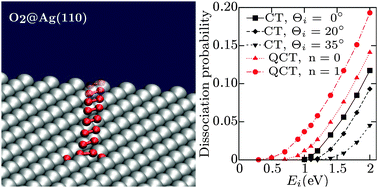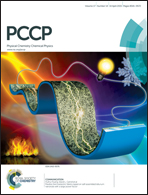Dissociative dynamics of O2 on Ag(110)†
Abstract
We study the dissociative dynamics of O2 on Ag(110) by performing classical and quasiclassical trajectory calculations on an adiabatic six-dimensional potential energy surface (PES). The PES is constructed from the interpolation of a large set of energies that are calculated using spin-polarized density functional theory. The minimum energy barrier to dissociation amounts to 0.36 eV. This value, which is considerably lower than the barriers of about 1.1 eV found in the Ag(100) and Ag(111) surfaces, is in line with the measured much higher reactivity of the (110) surface. Our classical dynamics calculations show that under normal incidence conditions no significant dissociation occurs below an initial energy of 0.9 eV (0.6 eV in the quasiclassical calculations). This result is an indication of a very much reduced configurational space leading to dissociation and also explains why direct dissociation has not been observed experimentally at low incidence energies. Our calculations also show that for off-normal incidence, most of the dissociation takes place close to the long-bridge site, a region of the configurational space where the energy barriers to dissociation are higher than 0.7 eV, resulting in still lower dissociation probabilities.



 Please wait while we load your content...
Please wait while we load your content...